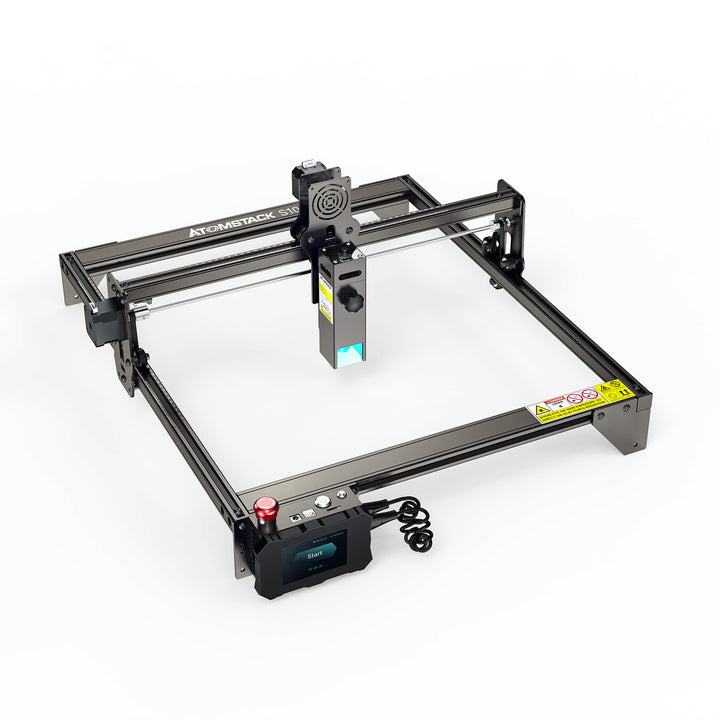atom stack by youke23
laser engraver
Prevent Burning and Scorching When Laser Cutting Monday, August 22, 2022 11:44:27 AM
One of the skills required for CO2 laser engraver and cutters is to try to avoid scorch marks on the edges of the engraving. For some materials, burn marks are unavoidable no matter where the laser's focus is. However, by using the correct substrate and following the directions carefully, you can minimize time-consuming cleanup during the cutting process.
In this article, we'll tell you what types of wood to avoid, and provide helpful tips on using lasers to cut wood without burning it.
What causes burn stains on cut wood?
The first thing to understand is that the laser beam never actually touches the surface of the wood. Just like inside a chimney, soot from the combustion of organic matter can deposit in the surrounding area. So there's no need to worry about laser damage to wood; it's just one example of taking precautions to avoid soiling woodworkers.
There are several ways to avoid these stains, the most popular is to apply tape to the wood surface. You can also modify laser cutter settings, apply coatings, use atomstack air assist—and make sure to choose the right wood, preferably one with a high moisture content.
Choose your wood carefully
Certain types of wood are better suited for laser cutting than others, mainly because of the amount of binder used to make certain wood materials. Laser cutters tend to work best on softer woods with simple grain patterns, such as alder and basswood.
Materials like plywood and MDF are more challenging due to their high glue content - but if you do need to use them, you always have the option of using tape, coating or sanding.
Softwoods: Softwoods such as balsa and alder require a low power setting and can be easily cut without too much resistance. Using lighter wood results in minimal contrast between the original surface and the newly cut edge.
Hardwoods: Hardwoods like cherry and oak are more likely to scorch than balsa because you need to use a stronger laser to engrave or cut the surface. The result of this is darker edges and a higher chance of burning.
Veneer: Veneer lumber uses wood as a surface material, so it works well for carving in many cases. It may not be suitable for laser cutting, depending on what the core material is.
Plywood: Plywood is one of the more difficult substrates to cut without burning, although it is possible if you use our tips below. It is one of the most versatile materials and comes in many sizes and styles. However, you'll want to choose one that's designed for laser cutting, such as birch plywood.
wavelength
Even the wavelength of the laser can affect the cutting edge of the material and a 1.06 micron fiber laser is not recommended. Conversely, 9.3 or 10.6 micron fiber bundles produced the fewest burn marks when cutting wood with a CO2 laser.
Resin content
The sap or resin content in the wood can make a huge difference when using a atomstack s10 pro laser cutter. Materials with a high resin content like alder are more prone to charring or have dark edges, while oak has a lower resin content and is better for a bright, clean cut.
test before starting
The type of wood you choose and even the thickness of a particular wood can have a big impact on your finished product. Speed, power, wattage and your environment also play a critical role. Therefore, we recommend that you always do a material test on offcuts before starting.
5 Tips for Preventing Burns When Laser Cutting
With a little patience and practice in the initial stages, there are some simple solutions to prevent burn marks from CO2 lasers.
1. Use transfer tape on the wood surface
You can apply masking tape to wood surfaces, but application tape comes in ready-made wide rolls that work perfectly with atomstack a5 pro laser engravers. You can apply tape to both sides of the product for a perfect clean. Use a small plastic spatula to firmly press down on the tape, making sure there are no air bubbles that could interfere with the cutting process.
The main disadvantage of this strategy is that it is time-consuming to apply the tape and then remove it. To make money with a laser cutter, speed is paramount—removing tape piece by piece can seriously impact productivity. Don't worry though - you can choose to use a plastic razor to effectively remove the tape.
2. Modify CO2 laser power settings
There are several settings you can use to avoid burning. Once you find a setting that works for each wood, you can jot it down to speed up the process in the future. The focus of the laser can be manually adjusted to make it slightly smaller. A slightly diffused laser reduces the amount of smoke produced while still providing enough energy to engrave or cut your material.


Please enter the text starting from the circled letter following the letters clockwise.
Post CommentThe line under a letter indicates orientation.